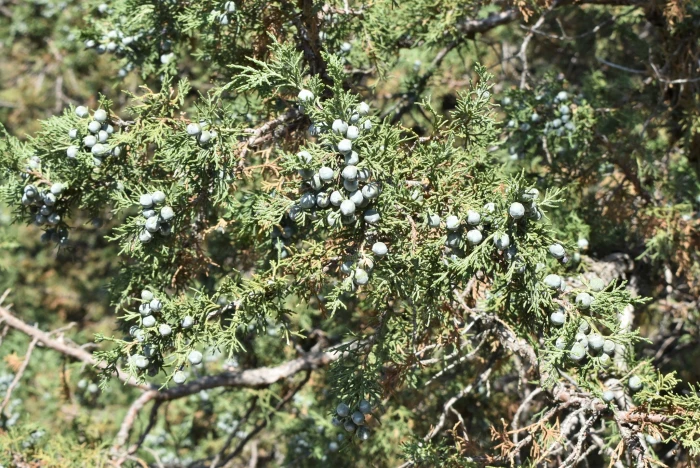Himalayan Pencil Juniper
(Juniperus semiglobosa)
Himalayan Pencil Juniper (Juniperus semiglobosa)
/
/

© Kudaibergen Amirekul
CC BY-SA 4.0
Image By:
© Kudaibergen Amirekul
Recorded By:
Copyright:
CC BY-SA 4.0
Copyright Notice:
Photo by: © Kudaibergen Amirekul | License Type: CC BY-SA 4.0 | License URL: http://creativecommons.org/licenses/by-sa/4.0/ | Uploader: amirekul | Publisher: iNaturalist |









Estimated Native Range
Climate Requirements for Palm Springs, Florida
| This Plant | Your Site | Plant Suitability for Your Location | ||
|---|---|---|---|---|
| • Precipitation | 1" - 66" | 60" | Aquatic | Aquatic |
| • High Temp. | 48°F - 97°F | 91°F | Your summer temperatures are normal for this plant. | Excellent |
| • Low Temp. | -20°F - 42°F | 57°F | OK, but your winter temperatures are warmer than normal for this plant | OK |
This plant may not grow well at your location - your precipitation is too high.
Summary
Juniperus semiglobosa, commonly known as Himalayan pencil juniper, is an evergreen coniferous shrub or small tree native to the high-altitude montane forests and alpine slopes of Central Asia, including Afghanistan, China, Pakistan, Kazakhstan, Kyrgyzstan, Nepal, India, Tajikistan, and Uzbekistan. It thrives at altitudes ranging from 5,090 to 14,500 feet where it is often exposed to harsh, windy conditions and poor, rocky soils. The Himalayan pencil juniper typically reaches a height of 16-49 feet and is characterized by its narrow, columnar form, flaky bark, and blue-black cones. The foliage is dense and composed of needle-like leaves that can vary in color from green to blue-green.
This species is valued for its hardiness and adaptability to extreme conditions, making it suitable for rock gardens and as a windbreak in high-altitude or exposed landscapes. It is also appreciated for its ornamental qualities, including its striking conical shape and attractive bark. In cultivation, it requires well-drained soils, tolerates drought once established, and prefers full sun to partial shade. While it is not commonly used in urban settings, it can be a unique addition to specialized plant collections. In its native region, it holds cultural significance and is used in religious ceremonies in Ladakh. Care should be taken when planting Juniperus semiglobosa, as it can be susceptible to juniper blight and may require protection from pests such as aphids and scale insects.CC BY-SA 4.0
This species is valued for its hardiness and adaptability to extreme conditions, making it suitable for rock gardens and as a windbreak in high-altitude or exposed landscapes. It is also appreciated for its ornamental qualities, including its striking conical shape and attractive bark. In cultivation, it requires well-drained soils, tolerates drought once established, and prefers full sun to partial shade. While it is not commonly used in urban settings, it can be a unique addition to specialized plant collections. In its native region, it holds cultural significance and is used in religious ceremonies in Ladakh. Care should be taken when planting Juniperus semiglobosa, as it can be susceptible to juniper blight and may require protection from pests such as aphids and scale insects.CC BY-SA 4.0
Plant Description
- Plant Type: Shrub, Tree
- Height: 15-20 feet
- Width: 8-12 feet
- Growth Rate: Moderate
- Flower Color: N/A
- Flowering Season: Non-Flowering
- Leaf Retention: Evergreen
Growth Requirements
- Sun: Full Sun
- Water: Low
- Drainage: Medium, Fast
Common Uses
Border Plant, Drought Tolerant, Low Maintenance, Rock Garden
Natural Habitat
High-altitude montane forests and alpine slopes
Other Names
Common Names: Himalayan Juniper, Himalayan Pencil Cedar, Himalayan Pencil Juniper, Pencil Cedar, Chalni, Eastern Juniper, Kun Lun Duo Zi Bai, Lewar
Scientific Names: Juniperus semiglobosa, Juniperus drobovii, Juniperus excelsa, Juniperus intermedia, Juniperus jarkendensis, Juniperus kokbulakensis, Juniperus media, Juniperus sabina var. jarkendensis, Juniperus schugnanica
GBIF Accepted Name: Juniperus semiglobosa